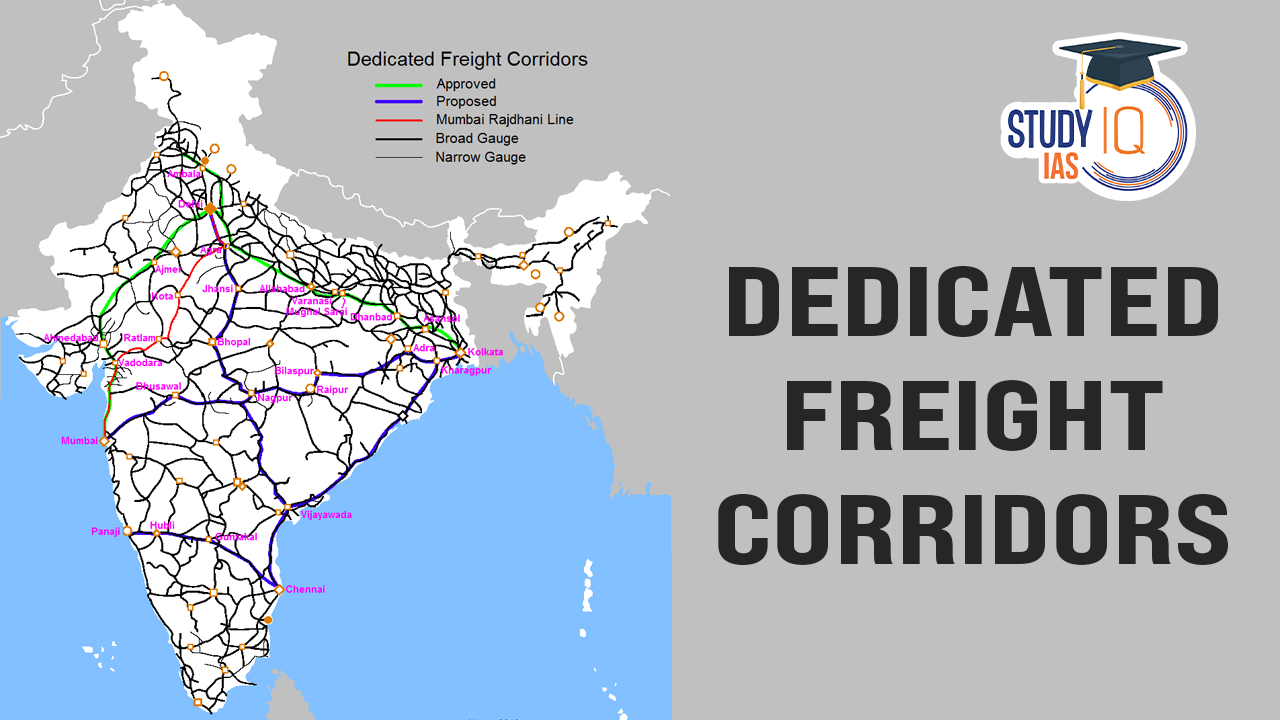Table of Contents
What are Dedicated Freight Corridors (DFCs)?
- They are specialised railway routes designed exclusively for freight transport. They enable faster and more efficient movement of goods.
- The creation of DFCs was announced in the Railway Budget for FY 2005-06. Dr. Manmohan Singh, the then Prime Minister, laid the foundation stone for the Eastern Dedicated Freight Corridor (EDFC) in Ludhiana in September 2006, and the Western Dedicated Freight Corridor (WDFC) in Mumbai in October 2006.
- On October 30, 2006, the Dedicated Freight Corridor Corporation of India Limited (DFCCIL) was established as a Special Purpose Vehicle for the construction, operation, and maintenance of the DFCs.
- On March 12, 2024, Prime Minister Narendra Modi inaugurated three new stretches of the DFC: 135 km Makarpura-Sachin section on the WDFC, and 179 km Sahnewal-Pilkhani & 222 km Pilkhani-Khurja sections on the EDFC.
- Benefits:
- Increased Capacity: DFCs allow for higher transport capacity, facilitating the operation of double stack container trains and heavy haul trains.
- Improved Supply Chain: These corridors enhance the supply chain for industries and logistics companies located near economic hubs, boosting export-import activities.
Need for Dedicated Freight Corridors (DFCs)
- Overutilization of Existing Rail Network: The Railways’ golden quadrilateral, linking Delhi, Mumbai, Chennai, and Howrah, along with its two diagonals (Delhi-Chennai and Mumbai-Howrah), constitutes only 16% of the total route but handles over 52% of passenger traffic and 58% of revenue-earning freight traffic.
- Declining Rail Freight Share: The Railways’ share of total freight traffic has been declining.
- The National Rail Plan aims to increase the rail freight share to 45% by 2030.
Current Status of DFCs
- Increased Train Operations: An average of 325 trains are now running daily on the DFCs, representing a 60% increase from the previous year.
- Freight Traffic Performance: Since its inception, DFCs have carried over 232 billion Gross Tonne Kilometres (GTKMs) and 122 billion Net Ton Kilometres (NTKMs) of payload.
- Share of Railways Freight: Over 10% of Indian Railways’ freight is now handled by the DFCs.
- Economic Impact Study: DFCCIL is conducting a comprehensive study to assess the DFCs’ impact on the Indian economy, with results expected soon.
Future Proposed Corridors
- East Coast Corridor: From Kharagpur to Vijayawada (1115 km).
- East-West Sub-corridors:
- Sub-corridor-I: From Palghar to Dankuni (2073 km).
- Sub-corridor-II: From Rajkharsawan to Andal (195 km).
- North-South Sub-corridor: From Vijayawada to Itarsi (975 km).


 How RBI Responded To Global Trade War Ch...
How RBI Responded To Global Trade War Ch...
 Why Confidence in US Dollar is Falling?
Why Confidence in US Dollar is Falling?
 Repo Rate and Reverse Repo Rate, Impact ...
Repo Rate and Reverse Repo Rate, Impact ...





















